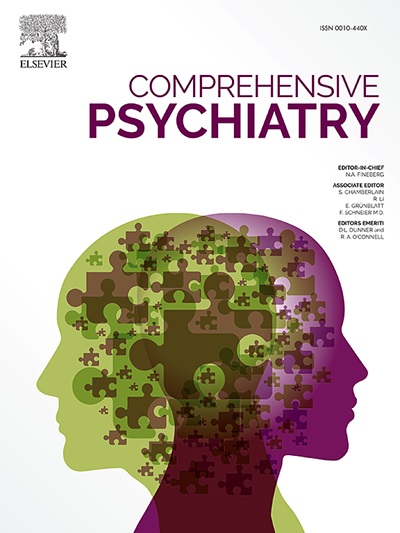Translation and validation of the Portuguese version of the internet severity and activities addiction questionnaire (ISAAQ-10) towards the identification of problematic social media use: A population study
IF 4.2
2区 医学
Q1 PSYCHIATRY
引用次数: 0
Abstract
Background
Problematic usage of the internet (PUI) refers to a pattern of internet use that results in negative consequences in an individual's life. It encompasses a broad spectrum of activities, which require assessment in terms of both severity and diversity, for a comprehensive understanding. This study aimed to translate the Internet Severity and Activities Questionnaire (ISAAQ-10) into Portuguese, to analyze its psychometric properties and to explore the validity of the ISAAQ-10 social networking use activity score towards identifying problematic social media use.
Methods
A snowball sampling method was used, with participants completing an online survey comprising sociodemographic questions and the Portuguese versions of the ISAAQ-10, Internet Addiction Test-10 (IAT-10), Internet Gaming Disorder Scale–Short-Form (IGDS9-SF), and Bergen Social Media Addiction Scale (BSMAS). The psychometric analysis included internal reliability testing using Cronbach's alphas and test-retest reliability, a confirmatory factor analysis (CFA), and convergent validity testing between the ISAAQ-10 and IAT-10. The concurrent validity of the ISAAQ-10 was also examined.
Results
A total of 590 young adults (85.1 % female), aged between 18 and 35 years, participated in this study. The ISAAQ-10 presented good internal consistency (α = 0.93), with a test-retest correlation of r = 0.865; 95 % CI: 0.669–0.939. and a unidimensional structure that explained 48.3 % of the total variance. The convergent validity of the ISAAQ-10's total score was established through a high Pearson's correlation (r = 0.574; p ≤ .001) with the IAT-10's total score. Pearson's correlations between the ISAAQ-10 gaming activity score and the IGDS9-SF (r = 0.873; p < .001), and between the ISAAQ-10 social networking use activity score and the BSMAS (r = 0.670; p < .001), respectively, supported the instrument's concurrent validity.
Conclusion
This work provides support for the Portuguese translation of the ISAAQ-10, which can be employed to identify the severity of problematic usage of the internet in a population sample. It also provides the first validation of the ISAAQ-10 social networking use activity score, which can be employed to identify problematic social media use within a predominately female university student sample. This study further establishes the ISAAQ-10 as a valid and reliable tool for population studies and, specifically, for the identification of problematic social media use.
葡萄牙语版互联网严重程度和活动成瘾问卷(ISAAQ-10)的翻译和验证,以识别有问题的社交媒体使用:一项人口研究
互联网使用问题(PUI)是指对个人生活造成负面影响的一种互联网使用模式。它包括范围广泛的活动,这些活动需要在严重性和多样性方面进行评估,以便全面了解。本研究旨在将互联网严重性和活动问卷(ISAAQ-10)翻译成葡萄牙语,分析其心理测量特性,并探讨ISAAQ-10社交网络使用活动评分在识别有问题的社交媒体使用方面的有效性。方法采用滚雪球抽样方法,参与者完成一项在线调查,包括社会人口学问题和葡萄牙语版本的ISAAQ-10、网络成瘾测试-10 (IAT-10)、网络游戏障碍简易量表(IGDS9-SF)和卑尔根社交媒体成瘾量表(BSMAS)。心理测量分析包括使用Cronbach's alpha和重测信度进行内部信度测试、验证性因子分析(CFA)以及ISAAQ-10和IAT-10之间的收敛效度测试。并对ISAAQ-10的并发效度进行了检验。结果共有590名年龄在18 ~ 35岁的年轻人(85.1%为女性)参加了本研究。ISAAQ-10具有较好的内部一致性(α = 0.93),重测相关r = 0.865;95% ci: 0.669-0.939。一维结构解释了48.3%的总方差。ISAAQ-10总分的收敛效度通过高Pearson相关(r = 0.574;p≤0.001)。ISAAQ-10游戏活动得分与IGDS9-SF之间的Pearson相关性(r = 0.873;p & lt;.001), ISAAQ-10社交网络使用活动得分与BSMAS之间(r = 0.670;p & lt;.001)分别支持该仪器的并发效度。本研究为ISAAQ-10的葡萄牙语翻译提供了支持,该翻译可用于识别人口样本中互联网使用问题的严重程度。它还首次验证了ISAAQ-10社交网络使用活动评分,该评分可用于在以女性为主的大学生样本中识别有问题的社交媒体使用。本研究进一步确立了ISAAQ-10作为人口研究的有效和可靠的工具,特别是用于识别有问题的社交媒体使用。
本文章由计算机程序翻译,如有差异,请以英文原文为准。
求助全文
约1分钟内获得全文
求助全文
来源期刊

Comprehensive psychiatry
医学-精神病学
CiteScore
12.50
自引率
1.40%
发文量
64
审稿时长
29 days
期刊介绍:
"Comprehensive Psychiatry" is an open access, peer-reviewed journal dedicated to the field of psychiatry and mental health. Its primary mission is to share the latest advancements in knowledge to enhance patient care and deepen the understanding of mental illnesses. The journal is supported by a diverse team of international editors and peer reviewers, ensuring the publication of high-quality research with a strong focus on clinical relevance and the implications for psychopathology.
"Comprehensive Psychiatry" encourages authors to present their research in an accessible manner, facilitating engagement with clinicians, policymakers, and the broader public. By embracing an open access policy, the journal aims to maximize the global impact of its content, making it readily available to a wide audience and fostering scientific collaboration and public awareness beyond the traditional academic community. This approach is designed to promote a more inclusive and informed dialogue on mental health, contributing to the overall progress in the field.
 求助内容:
求助内容: 应助结果提醒方式:
应助结果提醒方式:


